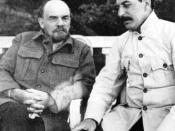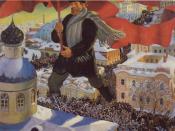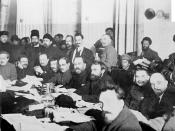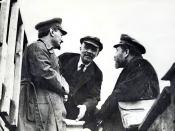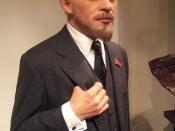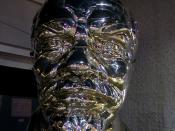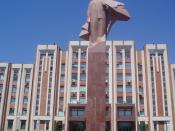On the eve of the October 1917 revolution in Russia, tensions had built up tremendously against Kerensky and the provisional government over its various decisions, (including the decision to keep Russia fighting against the Germans in world war one instead of pulling out). In the forefront of this revolutionary movement was one, Vladamir Illiyich Lenin, the leader of the Bolsheviks who had led them this far to victory by appealing to the masses with a simple slogan, "land, peace and bread," giving them genuine hope for the future. Having come to power in October 1917 by means of a coup d'ÃÂétat, Vladimir Lenin and the Bolsheviks spent the next few years struggling to maintain their rule against widespread popular opposition. They had overthrown the provisional democratic government and were inherently hostile to any form of popular participation in politics. In the name of the revolutionary cause, they employed ruthless methods to suppress real or perceived political enemies.
However for all of Lenin's good and patriotic qualities, when in power, he displayed a side which the people had not, seen in which Lenin was a more of totalitarian dictator than a fair leader of a country that had undergone a proletarian revolution. The small, elite group of Bolshevik revolutionaries which formed the core of the newly established Communist Party dictatorship under Lenin ruled by decree, enforced with terror. Lenin was responsible for enforcing terror upon his own people and controlling almost every aspect of their lives which is proved by many situation such as the virtual starvation of the red army which he decreed prior to demobilization after the civil war, or the Cheka requisitioning squads which reigned terror throughout the country side.
Moreover Lenin successor, Stalin was no different as he perpetrated just as much, or more, terror than Lenin by way of the great show trials and purges of the 30's and the persecution of the minorities and intelligentsia. However it has to be said that the terror Stalin unleashed, though might have resulted in a greater loss of life, but was not unique or the first time it was ever tried Lenin was the first to set up the concentration camps, (gulags), which Stalin later expanded. Lenin was also the first to destroy all democratic institutions in the country, replacing them with his totalitarian dictatorship of the communist party. He was also the first to persecute the minorities and the intelligentsia and thus the question, were Stalin's brutal methods a successor to Lenin's brutality or was the terror he perpetrated unique at the time? Lenin, the great leader of the Bolsheviks, was a very pragmatic man, always sticking to the practical realities in life. He only cared about results and not the way by which these results were obtained, thus for Lenin, the results justified the means of getting there. As can be seen from evidence uncovered in recent years from declassified documents in the KGB archives, Lenin was indeed a leader who advocated measures that were just as brutal as Stalin to control the people, however maybe not on the large scale that Stalin initiated his purges in the 30's. Lenin was a man who wanted to shoot workers if they didn't come for work during Christmas. He explained once to the food commision of the Petrograd Soviet on 27th january, 1918, "[as] long as we do not apply terror to speculators-shooting on the spot-we'll achieve nothing"æwe have to deal with thieves just as decisively-shooting on the spot." In fact, during the civil war, Lenin was ecstatic that Trotsky succeeded in turning a world war into a civil war. He of course did not think of the fact that it cost the country thirteen million lives and drove two Russians abroad. Lenin was also a man who chose to use lies as an effective medium of controlling the people and keeping the people happy and doing whatever was necessary to maintain his "ÃÂgrip.' He clearly showed this when he ensured the people in 1920, that the death penalty would be abolished. However after the Kronstadt anti-Bolshevik rebellion in 1921, Lenin made sure that anyone found inside a fortress or a ship would be executed. The statistics are staggering in regards to the death sentences issued by a special commission on 20th march, 1921 after the rebellion as ""æ167 marines from the battleship Petropavlovsk"æ" were sentenced to death and the, ""ænext day another thirty two were shot, and on 24 march a further twenty seven." In fact under Lenin, no means were spared to maintain control over rebellious "ÃÂelements' as at one point the commander of the 7th army attacked the battleships, Petropavlovsk and Sevastopol, ""æwith use of asphyxiating gas and poison shells"æ6459 were imprisoned or exiled"æ" However these few men were later shot in any case by Stalin.
Furthermore after the civil war, one would have thought that Lenin might have rewarded his victorious Red army. However, in 1921, just prior to the demobilisation of half a million troops, Lenin was faced with a dilemma in that, if the troops were all sent back home at once, the strain would be too great on the railway network, whereas if the demobilisation was to be taken at a more gradual pace, the troops would have to housed, clothed and fed, all of which would require a lot of expenditure and resources which people in the in cities needed. Thinking very coldly and practically, Lenin wrote to Zinoviev on 5th April 1921, and stated that, in reference to the red army, they should starve the army by giving them nothing at all which meant neither bread, clothes or boots. Lenin was really blackmailing his own army, telling them in effect to leave now on foot or wait for almost a year on very little food and not boots or clothing.
Lenin was also the first to make political assassinations a common tool, prior to even Stalin, for individuals who were a threat to the state and to Lenin and even people who just didn't agree with what Lenin thought/said. In fact, in early 1920, hearing the news that Admiral Kolchak had been caught by the Red army, he sent a telegram chief in Irkutsk, (where Kolchak was being kept), and told him, in effect, to sentence Kolchak to be shot and make it seem like the sentence was carried out due to the threat of "ÃÂwhite plots' in Irkutsk. The sentence was quickly executed within a few hours.
Additionally when Lenin hear that the white general Baron von Ungern-Sternberg was captured, he proposed, "we should aim for a solid accusation, and if theres plenty of evidence"æwe should organize a public trial, carry it out at maximum speed and shoot him." Lenin began the trend of holding public trial of criminals, (i.e. individuals who were a threat to the state and Lenin), and finding them guilty on all sorts of trumped up charges ranging from murder to espionage. His methods were just as brutal as Stalin's, resorting always to physically getting rid of an opponent. People who's only crime it was to criticise and not agree with Lenin suffered as well, as Nikholai Rozhkov did, (an economist and publicist), when he criticized War Communism and called for a move to more freer trade. Lenin grew suspicious of him and thus ordered for him to be exiled to Siberia in 1922. Ironically, Lenin did push through some similar free market reforms later in 1921, when NEP was introduced.
Lenin was the first, between him and Stalin, to create an atmosphere of paranoia in the masses, making them live in mortal fear of the dreaded secret police, the Cheka. In fact the situation got so bad that every person would be looking over their fellow mans shoulders to see how much they worked and how much they consumed and acting as the states "ÃÂcivilian' secret police. Those who did not do as the state told them to do, the threat of serious punishment was imminent, (i.e. the individuals may be sent to the gulag/labour camps, exiled or shot). The people that were most at risk were the intelligentsia, (i.e. the intellectuals), due to the fact that they were the only people in the state who were really capable of thinking for themselves and providing the only solid opposition Lenin, (and later Stalin) would encounter. The creation of slave labor camps or "ÃÂgulags' was one solution that Lenin began and Stalin continued to use on a bigger scale. Large numbers of people would be thrown into the gulag on a very regular basis which resulted in overcrowding of the gulags. In one situation, ""æ403 Cossack men and women"æarrived in Oryol for internment in the concentration camp." The cheka chief, Dzherzinsky reported that the camp couldn't accept them as they were already crowded. Lenin's solution: kill them. This resulted in almost a third of the Cossack population being exterminated on Lenin's order. Such brutality was shown, but on a larger scale by Stalin, leading us to the assumption that Stalin was just carrying on Lenin's policies on a wider scale and was not an aberration.
During the War communism era of Lenin's reign, Lenin gave the Cheka the authority to create requisitioning squads in order to requisition grain in order to feed the people in the cities, from peasants who supposedly were hoarding the grain and were speculating, waiting to get "ÃÂfantastic' prices for their harvest from the black market. These requisitioning squads went off to the country side using force and even killing peasants in order to confiscate their grain as even Lenin admitted in regard to the requisitioning squads, "We did not hesitate to shoot thousands of people and we shall not hesitate"æ" This was really the introduction and "ÃÂpopularisation' of a tool Stalin would use just as heavily in his reign, and that is the secret police, (in Lenin's time it was the Cheka and in Stalins it was the NKVD). In Lenin's time, the Politburo began by giving the Cheka authorisation to conduct "ÃÂextra-judicial' executions, or in other words, execution without trial.
Stalin touted himself to be Lenin's best pupil, and so he was right for he learnt the cruel ways of his teacher with great success as he applied them on an even larger scale than even Lenin. He had learnt from Lenin the art of mass terror, (which Stalin would later apply in his purges in the 30's), and political chicanery and cunning which enabled Lenin to kill off his rivals, (such as the Social Revolutionary's), or heinous acts like the murder of the entire Romanov family, and still keep his reputation intact. In fact Stalin established the sentence of hard labor in 1943. He certainly was intent on the destruction of his rivals and people he considered threats as he amended the judicial system, removing the defence and prosecution from trials, limiting the time of the trials to 10 days and stating that the death penalty, if rewarded, should be carried out immediately.
The secret police was a vital organ in the running of the soviet state under Stalin, and thus the NKVD, (the successor to the Cheka), powers were immense. At any one point in time the NKVD's special boards was ""æhandling hundreds of thousands of men and women condemned without any kind of trial." To relieve this load on the special boards, the rights of the special boards were passed down the NKVD troikas, (who were now empowered to do more than just sentence citizens to correctional or labor camps for a maximum of 5 years), in all the individual regions and republics as to spread the load. People were being sentenced up to 25 years of hard labor and imprisonment. Over the years, it seemed that the number of people being sent to the Gulags was increasing and thus a shortage of space in gulags was experience. On 5th march 1950 Stalin approved a capacity increase in a labor camp in moscow from ""æ180,000 to 250,000." In fact under Stalin there were more than, ""æfive million camp inmates and exiles at any one time," resulting in space allocated to a prisoner being very small, almost, ""æ1.8 square meters"æabout the size of a grave." Only the bare essentials were used for the camps, (i.e. barbed wire and tarpaulin tents).
The collectivisation that took place during the 5 years plans resulted in major losses in life, amounting up to 9.5 million lives as peasants who refused to give up their land to the collective farms or grain were either shot, tortured or exiled to Siberia, (more than a 1/3 had been shot or tortured or were exiled to Siberia).
The purges that took place throughout 30's during Stalin reign created a monumental loss of life, definitely greater than the amount of Jews Hitler exterminated during his Final Solution towards the end of World War two. All in all, in excess of 6 million people were killed during the purges, more than a million of those were shot. The only reason that can be seen for these purges are really the fact that Stalin wants to secure his power and destroy his rivals and potential threats. However as it occurred on many occasions, leaders of the "ÃÂdeviant' republics, (i.e. Georgian, Belorussian, Kazakh, Bashkir, etc.), were arrested and shot because they believed in keeping their separate national cultures and identities. Stalin killed them because they didn't agree with his policy of "ÃÂfusion of the nations' and like so, if people did not agree with Stalins policy, Stalin sent them to labor camps or had them shot, just as Lenin had earlier ordered the exile of prominent intelligentsia, (e.g. Rhykov), and other threats.
The military wasn't a prominent target for purges, however ironically, just before world war two when he needed his army to be strong, in 22nd May 1937, purges reached their zenith when Stalin order the arrest of the Marhsal of the Soviet Union Mikhail Tukhachevsky and other senior military men. Under intense interrogation, Tukhachevsky admitted to numerous trumped up charges, (such as spying), which led to him and his comrades being shot on 11th June, 1937. To make matters worse, a week afterwards, ""ætwenty one corps commanders, thirty seven divisional commanders, twenty-nine brigade commanders and dozen of regimental commanders and army commissars were arrested." Statistics reveal that from 1937-1939, almost 45,000 officers would be arrested and 1/3 of them were shot. A military report in October and November of 1941, 6,678 men were arrested, 357 were sentenced by military tribunals and 15 were shot on the spot.
One would have though that during the war, at least, the purges would have stopped. However, the purges continued, as the need for scapegoats for the tremendous losses Russia was apparent. General Dmitri pavlov, one of the many generals to be "ÃÂaxed,' was arrested, having to admit to charges of allying with Germany and opening the front to them, after being beaten up and forcefully persuaded to agree with the charges. Along with 4 other generals, they were shot. The same fate befell Marshall of the Soviet Union G. Kulik.
Blocking division, (units which were place behind the front lines in order to stop troops from retreating or escaping), which were used during the civil war during Lenins time, were used by Stalin during world war two as well. The sheer figures of the army men who put their lives at risk for their nation being sent to special camps or being shot or arrested is shocking. A full 16 divisions were sentence to death which makes Stalin brutality apparent.
If one were to compare Lenin and Stalin now and ask the question were Stalin's brutal methods a successor to Lenin's brutality or was the terror he perpetrated unique at the time? Then the answer would be that Lenin and Stalin were equally as brutal as each other which is evident from the brutalities they perpetrated such as Lenin's requisitioning squads, his introduction and empowerment of the cheka, (secret police), and Stalin's purges in the 30's and collectivisation. However there is a key difference between both these leaders and that's the span of time they were leaders of Russia. Stalin ruled over Russia for almost 25 years while Lenin only ruled for 6 years which logically resulted in Stalin being statistically being more brutal as he had more time to kill more people. This still however doesn't affect the conclusion that Stalin's brutal methods were successor to Lenin's brutality as both were just as brutal as each other, its only because Stalin had the advantage of more time and better technology that he ended up killing more people.
